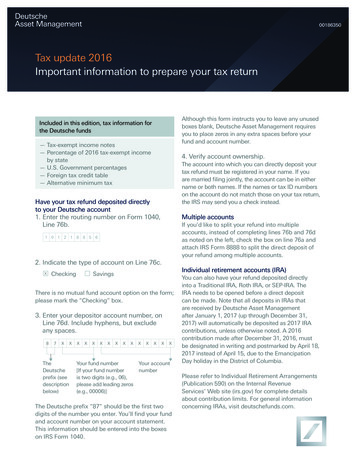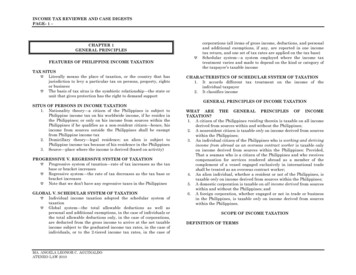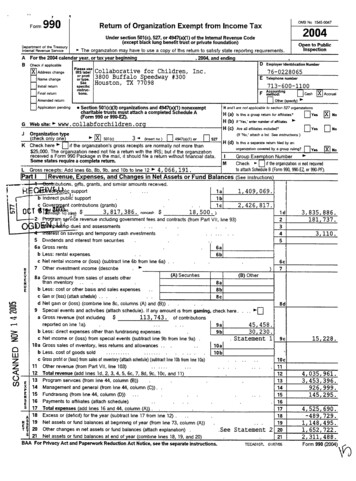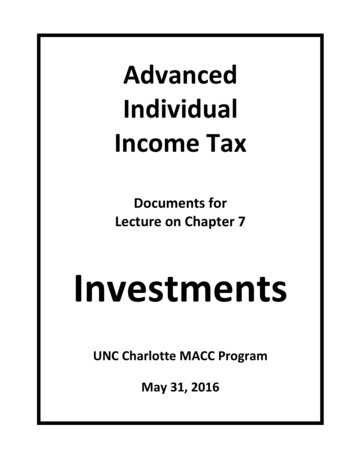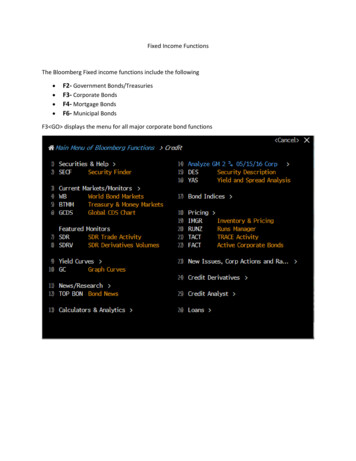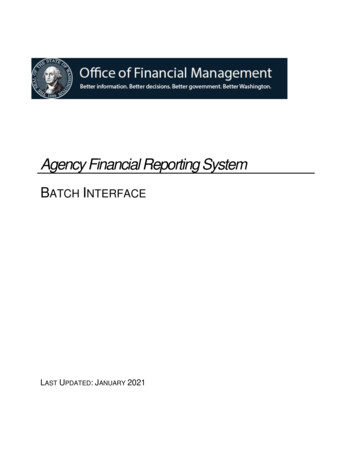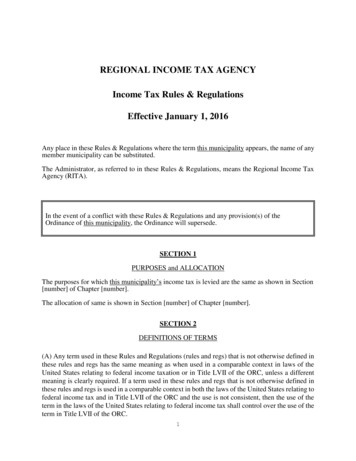
Transcription
REGIONAL INCOME TAX AGENCYIncome Tax Rules & RegulationsEffective January 1, 2016Any place in these Rules & Regulations where the term this municipality appears, the name of anymember municipality can be substituted.The Administrator, as referred to in these Rules & Regulations, means the Regional Income TaxAgency (RITA).In the event of a conflict with these Rules & Regulations and any provision(s) of theOrdinance of this municipality, the Ordinance will supersede.SECTION 1PURPOSES and ALLOCATIONThe purposes for which this municipality’s income tax is levied are the same as shown in Section[number] of Chapter [number].The allocation of same is shown in Section [number] of Chapter [number].SECTION 2DEFINITIONS OF TERMS(A) Any term used in these Rules and Regulations (rules and regs) that is not otherwise defined inthese rules and regs has the same meaning as when used in a comparable context in laws of theUnited States relating to federal income taxation or in Title LVII of the ORC, unless a differentmeaning is clearly required. If a term used in these rules and regs that is not otherwise defined inthese rules and regs is used in a comparable context in both the laws of the United States relating tofederal income tax and in Title LVII of the ORC and the use is not consistent, then the use of theterm in the laws of the United States relating to federal income tax shall control over the use of theterm in Title LVII of the ORC.1
(B) The singular shall include the plural, and the masculine shall include the feminine and thegender-neutral.(C) As used in these rules and regs:(1) "Adjusted federal taxable income," for a person required to file as a C corporation, or for aperson that has elected to be taxed as a C corporation under (C)(24)(d) of this division, means a Ccorporation's federal taxable income before net operating losses and special deductions as determinedunder the Internal Revenue Code, adjusted as follows:(a) Deduct intangible income to the extent included in federal taxable income. The deductionshall be allowed regardless of whether the intangible income relates to assets used in a trade orbusiness or assets held for the production of income.(b) Add an amount equal to five percent (5%) of intangible income deducted under division(C)(1)(a) of this section, but excluding that portion of intangible income directly related to the sale,exchange, or other disposition of property described in Section 1221 of the Internal Revenue Code;(c) Add any losses allowed as a deduction in the computation of federal taxable income if thelosses directly relate to the sale, exchange, or other disposition of an asset described in Section 1221or 1231 of the Internal Revenue Code;(d)(i) Except as provided in (C)(1)(d)(ii) of this section, deduct income and gain included infederal taxable income to the extent the income and gain directly relate to the sale, exchange, or otherdisposition of an asset described in Section 1221 or 1231 of the Internal Revenue Code;(ii) Division (C)(1)(d)(i) of this section does not apply to the extent the income or gain isincome or gain described in Section 1245 or 1250 of the Internal Revenue Code.(e) Add taxes on or measured by net income allowed as a deduction in the computation offederal taxable income;(f) In the case of a real estate investment trust or regulated investment company, add allamounts with respect to dividends to, distributions to, or amounts set aside for or credited to thebenefit of investors and allowed as a deduction in the computation of federal taxable income;(g) Deduct, to the extent not otherwise deducted or excluded in computing federal taxableincome, any income derived from a transfer agreement or from the enterprise transferred under thatagreement under Section 4313.02 of the ORC;(h)(i) Except as limited by divisions (C)(1)(h)(ii), (iii), and (iv) of this section, deduct any netoperating loss incurred by the person in a taxable year beginning on or after January 1, 2017.The amount of such net operating loss shall be deducted from net profit that is reduced by exemptincome to the extent necessary to reduce municipal taxable income to zero, with any remainingunused portion of the net operating loss carried forward to not more than five consecutive taxableyears following the taxable year in which the loss was incurred, but in no case for more years thannecessary for the deduction to be fully utilized.(ii) No person shall use the deduction allowed by division (C)(1)(h) of this section to offset2
qualifying wages.(iii)(a) For taxable years beginning in 2018, 2019, 2020, 2021, or 2022, a person may notdeduct, for purposes of an income tax levied by a municipal corporation that levies an income taxbefore January 1, 2016, more than fifty percent (50%) of the amount of the deduction otherwiseallowed by division (C)(1)(h)(i) of this section.(b) For taxable years beginning in 2023 or thereafter, a person may deduct, for purposesof an income tax levied by a municipal corporation that levies an income tax before January 1, 2016,the full amount allowed by (C)(1)(h)(i) of this section.(iv) Any pre-2017 net operating loss carryforward deduction that is available must beutilized before a taxpayer may deduct any amount pursuant to (C)(1)(h) of this section.(v) Nothing in division (C)(1)(h)(iii)(a) of this section precludes a person from carryingforward, use with respect to any return filed for a taxable year beginning after 2018, any amount ofnet operating loss that was not fully utilized by operation of division (C)(1)(h)(iii)(a) of this section.To the extent that an amount of net operating loss that was not fully utilized in one or more taxableyears by operation of division (C)(1)(h)(iii)(a) of this section is carried forward for use with respectto a return filed for a taxable year beginning in 2019, 2020, 2021, or 2022, the limitation described indivision (C)(1)(h)(iii)(a) of this section shall apply to the amount carried forward.(vi) In any return in which a net operating loss deduction is claimed, a schedule must beattached showing:(a) Year in which net operating loss was sustained.(b) Method of accounting and allocation used to determine the portion of net operatingloss allocable to this municipality for losses incurred for tax years prior to 2017.(c) Amount of net operating loss used as a deduction in prior years.(d) Amount of net operating loss claimed as a deduction in current year.(i) Deduct any net profit of a pass-through entity owned directly or indirectly by the taxpayerand included in the taxpayer's federal taxable income unless an affiliated group of corporationsincludes that net profit in the group's federal taxable income in accordance with division (V)(3)(b) ofSection 5.(j) Add any loss incurred by a pass-through entity owned directly or indirectly by the taxpayerand included in the taxpayer's federal taxable income unless an affiliated group of corporationsincludes that loss in the group's federal taxable income in accordance with division (V)(3)(b) ofSection 5.If the taxpayer is not a C corporation, is not a disregarded entity that has made an election describedin division (C)(48)(b) of this section, is not a publicly traded partnership that has made the electiondescribed in division (C)(24)(d) of this section, and is not an individual, the taxpayer shall computeadjusted federal taxable income under this section as if the taxpayer were a C corporation, exceptguaranteed payments and other similar amounts paid or accrued to a partner, former partner,3
shareholder, former shareholder, member, or former member shall not be allowed as a deductibleexpense unless such payments are in consideration for the use of capital and treated as payment ofinterest under Section 469 of the Internal Revenue Code or United States treasury regulations.Amounts paid or accrued to a qualified self-employed retirement plan with respect to a partner,former partner, shareholder, former shareholder, member, or former member of the taxpayer,amounts paid or accrued to or for health insurance for a partner, former partner, shareholder, formershareholder, member, or former member, and amounts paid or accrued to or for life insurance for apartner, former partner, shareholder, former shareholder, member, or former member shall not beallowed as a deduction.Nothing in division (C)(1) of this section shall be construed as allowing the taxpayer to add or deductany amount more than once or shall be construed as allowing any taxpayer to deduct any amountpaid to or accrued for purposes of federal self-employment tax.(2)(a) "Assessment" means a written finding by the Tax Administrator that a person hasunderpaid municipal income tax, or owes penalty and interest, or any combination of tax, penalty, orinterest, to the municipal corporation that commences the person's time limitation for making anappeal to the Board of Tax Review pursuant to Section 21, and has "ASSESSMENT" written in allcapital letters at the top of such finding.(b) "Assessment" does not include a notice denying a request for refund issued under division(C)(3) of Section 9, a billing statement notifying a taxpayer of current or past-due balances owed tothe municipal corporation, a Tax Administrator's request for additional information, a notification tothe taxpayer of mathematical errors, or a Tax Administrator's other written correspondence to aperson or taxpayer that does not meet the criteria prescribed by division (C)(2)(a) of this section.(3) "Audit" means the examination of a person or the inspection of the books, records,memoranda, or accounts of a person, ordered to appear before the Tax Administrator, for the purposeof determining liability for a municipal income tax.(4) "Board of Review" means the entity created under ORC 718.11 constituted to hear appeals ofmunicipal income tax matters.(5) "Calendar quarter" means the three-month period ending on the last day of March, June,September, or December.(6) "Casino operator" and "casino facility" have the same meanings as in Section 3772.01 ofthe ORC.(7) "Certified mail," "express mail," "United States mail," "postal service," and similarterms include any delivery service authorized pursuant to Section 5703.056 of the ORC.(8) "Disregarded entity" means a single member limited liability company, a qualifyingsubchapter S subsidiary, or another entity if the company, subsidiary, or entity is a disregarded entityfor federal income tax purposes.(9) “Domicile” means the true, fixed, and permanent home of a taxpayer and to which, wheneverabsent, the taxpayer intends to return. A taxpayer may have more than one residence but not more4
than one domicile.(10) "Employee" means an individual who is an employee for federal income tax purposes, andwho works for income, qualifying wages, salary, commission or other type of compensation in theservice of and under the control of an employer. The relationship of employer and employee existswhen the person for whom services are performed has the right to control and direct the individualwho performs the services, not only as to the result to be accomplished, but also as to the details andmeans by which that result is accomplished. Any person from whom an employer is required towithhold for federal income tax purposes shall prima facie be deemed an employee.(11) "Employer" means an individual, association, corporation or other entity that is an employerfor federal income tax purposes, and who or that employs one or more persons on an income, salary,qualifying wage, commission or other compensation basis, whether or not such employer is engagedin business or operated for a profit, and whether or not the entity is private or public. No rights,duties or obligations are imposed with respect to any such body not otherwise authorized by law.A person who employs domestic help for such person's private residence shall not be considered anemployer of the domestic for municipal income tax withholding purposes, and shall not be requiredto withhold and/or remit municipal income tax on behalf of the domestic help.(12) "Exempt income" means all of the following:(a) The military pay or allowances of members of the armed forces of the United States ormembers of their reserve components, including the national guard of any state. This exemptionincludes not only the military pay and allowances received by the member, but also the military payand allowances, such as dependency allowances, received by another person by reason of themember's service.(b) Intangible income. However, a municipal corporation that taxed any type of intangibleincome on March 29, 1988, pursuant to Section 3 of S.B. 238 of the 116th general assembly, maycontinue to tax that type of income if a majority of the electors of the municipal corporation votingon the question of whether to permit the taxation of that type of intangible income after 1988 votedin favor thereof at an election held on November 8, 1988.(c) Social security benefits, railroad retirement benefits, unemployment compensation,pensions, retirement benefit payments, payments from annuities, and similar payments made to anemployee or to the beneficiary of an employee under a retirement program or plan, disabilitypayments received from private industry or local, state, or federal governments or from charitable,religious or educational organizations, and the proceeds of sickness, accident, or liability insurancepolicies. As used in division (C)(12)(c) of this section, "unemployment compensation" does notinclude supplemental unemployment compensation described in Section 3402(o)(2) of the InternalRevenue Code.(d) The income of religious, fraternal, charitable, scientific, literary, or educational institutionsto the extent such income is derived from tax-exempt real estate, tax-exempt tangible or intangibleproperty, or tax-exempt activities.(e) Compensation paid under Section 3501.28 or 3501.36 of the ORC to a person serving as a5
precinct election official to the extent that such compensation does not exceed 1,000 for the taxableyear. Such compensation in excess of 1,000 for the taxable year may be subject to taxation by amunicipal corporation. A municipal corporation shall not require the payer of such compensation towithhold any tax from that compensation.(f) Dues, contributions, and similar payments received by charitable, religious, educational, orliterary organizations or labor unions, lodges, and similar organizations;(g) Alimony and child support received.(h) Compensation for personal injuries or for damages to property from insurance proceeds orotherwise, excluding compensation paid for lost salaries or wages or compensation from punitivedamages.(i) Income of a public utility when that public utility is subject to the tax levied under Section5727.24 or 5727.30 of the ORC. Division (C)(12)(i) of this section does not apply for purposes ofChapter 5745. of the ORC.(j) Gains from involuntary conversions, interest on federal obligations, items of income subjectto a tax levied by the state and that a municipal corporation is specifically prohibited by law fromtaxing, and income of a decedent's estate during the period of administration except such incomefrom the operation of a trade or business. Gains from cancellation of indebtedness (individualtaxpayers only) to the extent exempt from federal income tax.(k) Compensation or allowances excluded from federal gross income under Section 107 of theInternal Revenue Code. The exclusions apply only to an individual taxpayer that is duly ordained,commissioned, or licensed by a religious body constituting a church or church denomination, andhaving the authority to perform all sacraments of the church or religious body.(l) Employee compensation that is not qualifying wages as defined in division (C)(35) of thissection.(m) Compensation paid to a person employed within the boundaries of a United States airforce base under the jurisdiction of the United States air force that is used for the housing ofmembers of the United States air force and is a center for air force operations, unless the person issubject to taxation because of residence or domicile. If the compensation is subject to taxationbecause of residence or domicile, tax on such income shall be payable only to the municipalcorporation of residence or domicile.(n) An S corporation shareholder's share of net profits of the S corporation, other than any partof the share of net profits that represents wages as defined in Section 3121(a) of the Internal RevenueCode or net earnings from self-employment as defined in Section 1402(a) of the Internal RevenueCode. This exemption does not apply if the voters of this municipality passed an S corporationballot issue in 2003 or 2004 regarding taxation of S corporations.(o) To the extent authorized under a resolution or ordinance adopted by this municipalitybefore January 1, 2016, all or a portion of the income of individuals or a class of individuals under18 years of age. The taxable portion of the year in which an individual turns 18 shall be determined6
by the birth-date of the individual.(p)(i) Except as provided in divisions (C)(12)(p)(ii), (iii), and (iv) of this section, qualifyingwages described in division (C)(2) or (5) of Section 4 to the extent the qualifying wages are notsubject to withholding for this municipality under either of those divisions.(ii) The exemption provided in division (C)(12)(p)(i) of this section does not apply withrespect to the municipal corporation in which the employee resided at the time the employee earnedthe qualifying wages.(iii) The exemption provided in division (C)(12)(p)(i) of this section does not apply toqualifying wages that an employer elects to withhold under division (C)(4)(b) of Section 4.(iv) The exemption provided in division (C)(12)(p)(i) of this section does not apply toqualifying wages if both of the following conditions apply:(a) For qualifying wages described in division (C)(2) of Section 4, the employee'semployer withholds and remits tax on the qualifying wages to the municipal corporation in which theemployee's principal place of work is situated, or, for qualifying wages described in division (C)(5)of Section 4, the employee's employer withholds and remits tax on the qualifying wages to themunicipal corporation in which the employer's fixed location is located;(b) The employee receives a refund of the tax described in division (C)(12)(p)(iv)(a) of thissection on the basis of the employee not performing services in that municipal corporation.(q)(i) Except as provided in division (C)(12)(q)(ii) or (iii) of this section, compensation that isnot qualifying wages paid to a nonresident individual for personal services performed in thismunicipality on not more than 20 days in a taxable year.(ii) The exemption provided in division (C)(12)(q)(i) of this section does not apply undereither of the following circumstances:(a) The individual's base of operation is located in this municipality.(b) The individual is a professional athlete, professional entertainer, or public figure, andthe compensation is paid for the performance of services in the individual's capacity as a professionalathlete, professional entertainer, or public figure. For purposes of division (C)(12)(q)(ii)(b) of thissection, "professional athlete," "professional entertainer," and "public figure" have the samemeanings as in Section 4 (C).(iii) Compensation to which division (C)(12)(q) of this section applies shall be treated asearned or received at the individual's base of operation. If the individual does not have a base ofoperation, the compensation shall be treated as earned or received where the individual is domiciled.(iv) For purposes of division (C)(12)(q) of this section, "base of operation" means thelocation where an individual owns or rents an office, storefront, or similar facility to which theindividual regularly reports and at which the individual regularly
Jan 01, 2016 · means the examination of a person or the inspection of the books, records, . ” means the true, fixed, and permanent home of a taxpayer and to which, whenever absent, the taxpayer intends to return. A taxpayer may have more than one residence but not more . 5 . than one domicile. (10)


